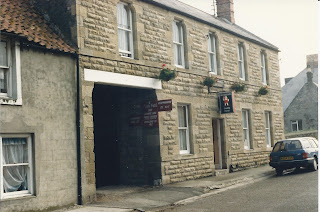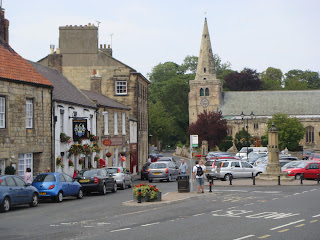Lindisfarne, or Holy
Island, is part island and part peninsula. Unless you own a boat, the only
access from the mainland is over a long, narrow causeway at low tide. When the
tide turns, Lindisfarne becomes an island again. This unusual feature was a
major attraction for us in the early 1970s, when English licensing
laws stipulated that all pubs must close at 10.30 pm, even at weekends. To avoid
this draconian law, we often made our way north from County Durham to spend a
few nights on the island. Once ensconced in the Crown and Anchor, we were able
to drink until the early hours, safe in the knowledge that a police raid was
highly unlikely.
In 1973, there were
four pubs on the island - The Crown and Anchor, The Northumberland Arms (also
known as The Ship), The Castle Hotel and The Iron Rails.
Note the photograph of The Queen on the wall above the fireplace.
Terry Smith, Landlord
Colin Mole and fierce dog outside the Crown and Anchor in 1973
The night Mrs Mole saved Terry
Smith’s life but not his embarrassment
Our accommodation on Lindisfarne in the 1970s was a
room (well, a wooden shed) situated at the back of the Crown and
Anchor. One morning, in the early hours,
young Terry Smith nipped into the pub toilets, unaware that there was a couple
of Rottweilers on the loose. As he attempted to leave the toilets, he was met by
two snarling dogs. In desperation, Terry called for help and after a while the
Landlord's wife heard his cries and called the dogs away. Terry emerged from the
Gents wearing nothing but a pair of purple
underpants, much to the amusement of Mrs Mole. She never let the poor lad
forget it.
Mrs Mole, Terry
Smith, Colin Mole and two regulars in The Crown and Anchor on 1st April
1973. All played a part in the Great Osprey Hoax.
The Crown and Anchor in June 1986
The Castle Hotel in 1986
The Crown and Anchor in 1986. Note the white shed,
which often served as our accommodation in the 1970s, to the right of the pub.
The Former Iron Rails in 1986
The Northumberland Arms (later known as The Ship) in 1986
The Crown and Anchor in November 1999
The (former) Iron Rails in November 1999, looking more
prosperous with the stone walls exposed.
The Ship (formerly The Northumberland Arms) in November
1999
The Great Osprey Hoax
One bitterly cold weekend at the end of March 1973, a group
of us were comfortably installed in The Crown and Anchor. While Terry Smith,
Alan Billingham and myself were content to sit in the bar drinking beer, Baron
Styxton had far more adventurous thoughts. He was fascinated by the wildlife on
the island and tried to encourage us to investigate the sand dunes. This proved
too much for us and so the legend of the osprey was born.
During one of the Baron’s absences from the bar (well,
beer does have that effect), we concocted a plan to give us some peace and
quiet. We agreed, with the connivance of the Landlord, his wife and a few
locals, to tell him about the unprecedented appearance on the island of an
osprey. When the Baron returned, someone carefully introduced the theme of this
rare bird and sightings on the far corner of the island. The Baron was hooked
and listened with increasing fascination to stories about this bird. As the
evening rolled on, descriptions of the animal and its habits became increasingly
fantastic and often contradictory, but with the liberal application of beer,
The Baron continued to believe. Sometime after midnight, we left the bar for a
good night’s sleep in our shed. Baron Styxton was now determined to see the
osprey for himself, even though he knew the only chance was to cross the dunes
at dawn.
At daybreak, Terry, Alan and I were awoken by The Baron
readying himself for his great ornithological expedition. He tried in vain to persuade us to accompany him but we all resisted,
preferring to stay in bed. Eventually, armed with a camera, The Baron left the shed. After a few
minutes, we carefully peeked out of the window to observe the lone figure of
Styxton tramping across the deserted, freezing sand dunes, determined in the face
of a North Sea gale. It was 1st April 1973.
Hours later, when we were sitting comfortably in the
bar, The Baron returned. He was nithered (frozen to the bone). He had spent
hours looking for a non-existent bird. The only animal he had seen was a dead seagull. Of course
no-one dared to mention the truth.
A couple of months later, a group of us were gathered
in The Norseman in Peterlee for a session. Someone asked The Baron about his
unsuccessful search for the osprey. After a few stories about the weekend,
somebody else asked Styxton if he remembered the date of our trip to Lindisfarne.
As the truth finally dawned, his face darkened and several of us were forced to
leave the bar in a hurry.
This incident was followed by several dreadful bird-related
puns, including ‘let us pray’ before taking a drink of beer, ‘it was only a
yolk, Baron’ and ‘set a good eggsample, Styxton’. On one occasion, The Baron returned
to his seat to find that someone had clipped a plastic bird with spring legs to his pint glass. Fortunately, Styxton took all this in his stride and continued drinking.
Britain might have hit a low point in fashion in the
1970s, but there is still no excuse for this lot. Gordon Walton, Tony Doyle,
Alan Billingham (wearing straw hat) and Martin Allen on Lindisfarne in 1973.


























